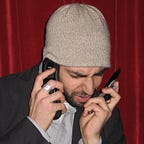School safety… during a pandemic. Part I.
A six-part dialogue between an architect + an educator. With a soundtrack. One year later.
In the 2019–2020 academic year, Barry Svigals was a fellow with our K12 Lab at the Stanford d.school. The purpose of the fellowship was to utilize design approaches to reimagine school safety. Barry brought decades of experience designing K-12 school buildings to this endeavor, including the design of the new Sandy Hook Elementary School. When COVID-19 forced us to shelter-in-place, Barry and I were in the last week of co-teaching a course called Safe By Design which brought together Stanford students and students from ASCEND Middle School in Oakland. We were in the midst of digging into research on student wellbeing, developing collaborations with several national organizations dedicated to school safety, and designing prototypes to help change conversations about what safety can and should mean for K-12 communities.
The pandemic dramatically shifted our work. Our last class session happened via videoconference. We went from meeting for design sessions in our “sprint space” at the d.school to meeting by phone and communicating by letter. And the content of our work shifted as well. Prior to the pandemic, conversations about school safety were almost entirely about preventing school shootings, now they were about preventing infections. More widespread consideration was being given to students’ mental and emotional wellbeing.
Trying to make sense of this shifting terrain, one year ago this week, we exchanged a series of letters—each one with an accompanying song we selected. A year later, we are re-examining these missives to one another. To remember. To measure if and how we have changed since then. To consider what we have learned. We have decided to share them with you here in the hopes that they might remind you of how much has changed and we have learned and adjusted—and how much hasn’t and we have not. As you read these small time capsules of thoughts, please consider how you think about safety and wellbeing.
We are publishing two each day over a four day period. Please play the song, read the notes, and leave us your thoughts.
DAY ONE
April 7th, 2020
Dear Barry,
Over the last few months, a dangerous intruder has entered our world. We can’t see him. But we see the carnage he leaves in his path. One of his most sadistic tendencies is to unleash prolific uncertainty on all of us. He kills some. He tortures others. And for reasons we don’t understand, he spares some entirely. Hiding doesn’t stop him. But it does slow him down.
It’s terrifying. Even as many of us have avoided his clutches, he’s in our psyche.
It feels like the height of hubris to suggest that we know anything about this moment and what it requires. How could we?
And yet.
We have spent the last several months studying fear and its impact on children and the adults entrusted to take care of children. Again and again, the double-edged blade has been revealed: many of the very things designed to keep us safe often make us feel less safe. If an adult walks into a classroom full of students and says, “Now it’s time for the active shooter drill,” what new idea have they indelibly introduced to that group of children?
April 7th, 2020
Dear sam,
To me this points to the importance of seeing the unintended consequences of addressing one issue independent of others. We might ask: in the effort to protect our children from extreme violence which rarely occurs, what have we forgotten? What problems are we NOT addressing? When we see how tens of thousands of students stay home everyday because of bullying, do we make a proportional commitment to ameliorating that ubiquitous suffering? And can we be creative enough to see wellbeing and safety as complementary aspirations?
There’s another dimension we see in that question involving an “active shooter” which is often not acknowledged. Language and the specific words we use to express ourselves can inadvertently create its own dynamic, deepening our fears and subverting our intentions. Imagine a fire drill that begins with “Now students we’re going to try and avoid having you trapped in this room and burnt alive.” More importantly, can we see the possibility of using language in an inspirational way, to allow for behavior that nurtures rather than traumatizes?
And speaking of hubris… actually, I think we’ve repeatedly returned to the fact that we don’t know. Doesn’t knowing we don’t know acknowledge our commitment to the search? And isn’t this a search for the animating question, the one that illuminates the path. Isn’t what we’re doing an effort to shine a light on what we’re seeing?
Looking back a year later, schools’ ability to navigate the particular dynamics of the pandemic have evolved dramatically since we wrote these letters. Yet communities are still struggling with many of the same issues: deepening systemic inequities, lack of community consensus, and core needs of the wellbeing of the people within school communities too frequently being valued below test scores and the most obvious physical dangers. Even as the most haunting threat has shifted from violence to virus, and now hovers as a hybrid, we have found that focusing on fear distracts us from remembering our most essential aspiration: Our students need to feel safe to be safe. Learning environments must nourish the wellbeing of the students. Every safety strategy must serve that aim.
We’re curious what you think:
How are these concepts applicable as more and more students and educators return to school buildings? How have things changed? What new questions must we be asking?
For more questions about school safety—and a place to pose your own—visit ReimagineSchoolSafety.org
Join us again tomorrow for the next installment of letters and tunes.
